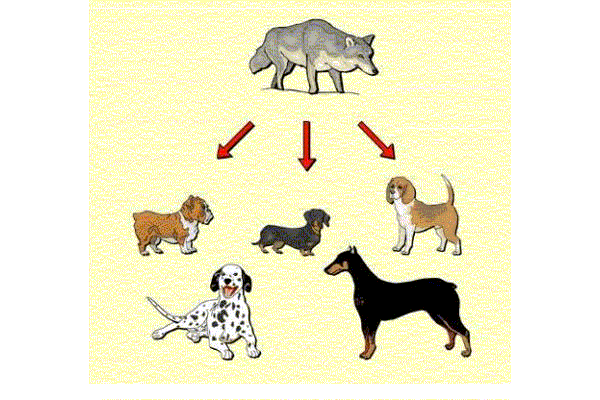The Independent Center for Integrative Education: Learning without Limits
01/18/2011
Today, our topic was genetics: genes, DNA, mutations, natural and artificial selection, and genetical engineering. Please read the summary below and the homework assignment at the bottom.
As there were only four students present, mainly due to severe weather conditions, we will go over those topics (in more depth) again when we meet on Tuesday, January 25.
We started with a discussion of the discovery made by Gregor Mendel, the Augustinian monk, whose work, published in 1866, was largely ignored until the beginning of the XX century.

Before Mendel, everybody believed that if you crossbreed two animals or plants with different features, the hybrids will have those features somewhere in between those of the parents. For example, if one parent is tall and another is short, the children will be of an average height. This opinion was shared by the best biologists including Darwin. There were some examples that supported such views.
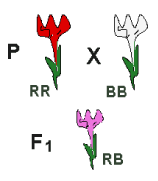
What Mendel discovered was so revolutionary that scientists preferred to ignore the findings rather than dealing with them. Mendel found that the offsprings inherit the full feature from either mother or father. For example, the peas that he studied were either yellow or green but never something in between.
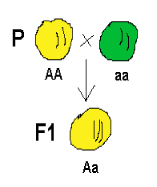
He studied many other features besides color. The result was always the same.
Moreover, he found that in the second generation, a third of the offsprings inherit from one of the grandparents and two thirds of the offspring inherit from the other.
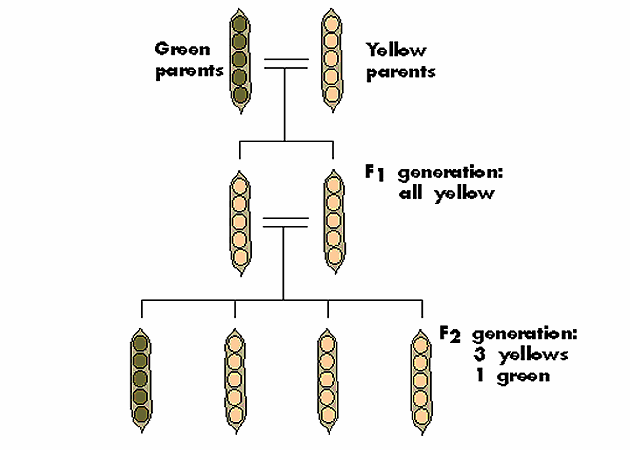
He experimented with some 30,000 pea plants and was absolutely sure about his findings. He provided the following explanation.
Traits of organisms are defined by some inheritable things that he called alleles. For each trait there are two alleles. The two alleles may be different, but the appearance will be fully defined by one of them, which he called dominant. The silent one he called recessive. Purebred plants had two identical alleles, for example, if there are two color-defining green alleles, the result will be green peas; and if both alleles are yellow, the resulting peas will be yellow. Therefore, purebred plants always produce purebred offsprings. No surprises so far.
The interesting part started when Mendel cross-pollinated two different purebred plants. The alleles are now randomly distributed among the offsprings, and there may occur the following combinations: GG, GY, YG, and YY, where Y and G represent the alleles that result in yellow and green peas respectively. In each pair, the first allele comes from the father and the second comes from the mother. The yellow allele happens to be dominant and the green allele is recessive (silent), so three out of every four siblings will be yellow. Using the same approach, Mendel could calculate the composition of the third and following generations, and his calculations were always in agreement with his experiments.
The material representation of the alleles is called genes (alleles are not genes; for each gene, alleles are different modifications of it). It was found much later, when experiments showed that all genetical information is somehow stored in the long molecules called desoxyribonucleic acid or DNA for short. Inorganic molecules such as CO2 contain just a few atoms, but DNA may contain as many as 30 billion atoms and be up to 10 ft. long.
In 1953, James Watson and Francis Crick discovered the structure of the DNA molecule, which explained how the genetic information is stored. The molecule happens to consist of two strands (linear chains) of special atomic structures called bases.. There are four types of bases called adenine (A), thymine (T), guanine (G), and cytosine (C), which serve as letters in a four-letter alphabet of life.. They are grouped into triplets called codons . Each triplet codes one of the 21 amino acids that are the building blocks of proteins. The structure of proteins defines the features of any living organism.

Watson, Crick and DNA model, 1953
Single strands of DNA are not stable. A second strand forms rapidly connected to the first one. There is a strong affinity (attraction) between pairs of bases, with A attracted to T and G attracted to C, so the second strand copies the first one as a negative copies a positive. The resulting two-strand structure has a shape of a double helix.

Not only can such molecules store tremendous amount of information and are quite stable, they also can replicate themselves letter for letter. A special molecular machine (enzyme) moves along the molecule separating the strands. The strands immediately capture bases from the nearby cellular liquid and build the second strand, so after the process is complete, two identical DNA molecules are present. One of them may stay and the other may go to an offspring enabling inheritance.

It so happens that each DNA molecule is present in every cell of our (and everybody else's) body twice, and the copies are not identical. That is where Mendel's alleles come from.
Stable as the DNA molecules are, they may be damaged by radiation or aggressive chemicals and their structure may change. Such changes are called mutations. Some of the changes will be dangerous or purely lethal, and it is good that there is a second copy of the same code in the second molecule. Not all changes are bad, some of the them are actually useful.
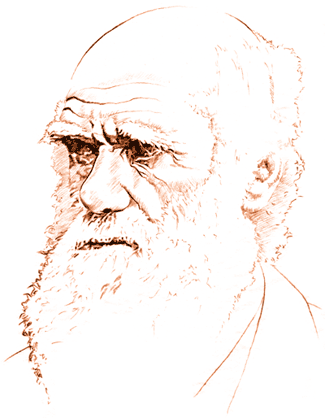
Charles G. Darwin
Natural selection described by Darwin, tends to eliminate the "bad" mutations and promote the "good" ones. As a result, the organisms evolve. We as a species have common ancestors with all other animals, starting from the simplest unicellular (consisting of only one cell) organisms. Many mutations resulted in "inventions" of such useful things as the brain, the bones, the limbs, hair, and infinitely more.
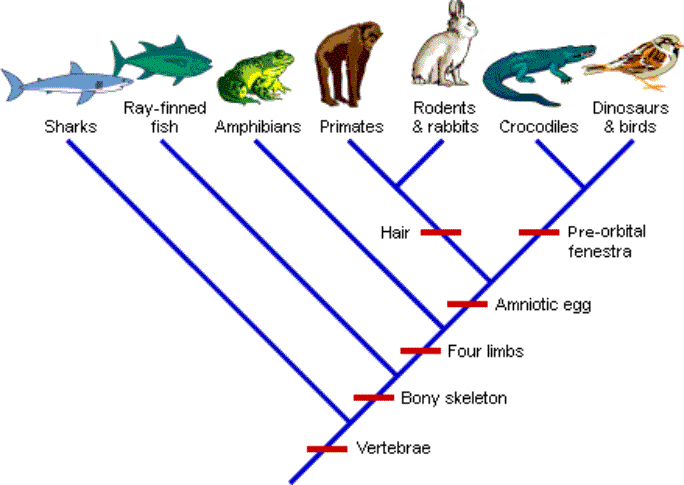
Besides animals and plants, biologists today recognize three other groups of organisms, namely fungi, protista, eubacteria, and archaebacteria, the latter three being mainly unicellular. These groups are called Kingdoms.
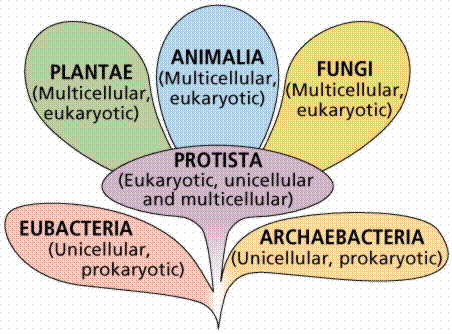
Different as the kingdoms are, they all apparently share a common ancestor because the genetical mechanism of all living creatures today is identical. It is a complete mystery how, when, and where such a complex machinery has evolved.
Nature is not the only one responsible for changes and evolution. People have created new animals and plants for millennia. They used what Darwin called artificial selection (in contrast to natural selection). This process is also known as selective breeding. Artificial selection means that humans rather than nature favor specific desirable traits and eliminate the traits that are not useful. There is no real difference in the genetic processes underlying artificial and natural selection.
Please click on the image for an interesting slide show.
Infamous examples of artificial selection are the raise in resistance of some pathogenic (causing disease) bacteria to antibiotics and the increasing ability of bedbugs to withstand the pesticides used to combat them. Click here for an interesting Wall Street Journal article on bedbug evolution.
Selective breeding has some limitations. First, there may not be organisms with desirable traits in the population. Natural mutations do not happen often enough and they rarely change the organism in the desirable direction. In other words, there may be nothing to select from. Scientists tried to increase the rate of mutations using radiation, but this usually resulted in deformed organisms not suitable for further selection. Second, the selection may require many generations and therefore take a very long time. In addition, selecting for one trait may result in the deterioration of another.
Recently, another way to create new animals and plants was developed. It is called genetic engineering. It is possible now to take some genes from one organism and implant them into another. If this is done with the egg, a single cell from which the whole organism will develop, those new genes will be present in every cell and will even be inherited. When scientists added genes responsible for glowing in the dark taken from a jellyfish to the DNA of Zebrafish, they obtained fish that glow in the dark. This fish, called GloFish, became the first genetically modified animal available as a pet. Click here for the pictures of other bizarre genetically engineered animals.
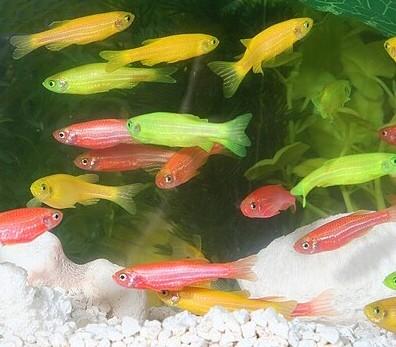
GloFish
Less exotic examples of genetically modified organisms is found in agriculture. For example, there are grains resistant to pests and therefore needing less or no pesticides. Our government, after performing research, considers eating genetically modified food safe, although there is little scientific data about the long-term effects. On the biochemical level, no difference between natural and genetically engineered crops and meats was found. Nevertheless, the issue remains controversial.
This homework assignment is just a copy of the previous one. All of us are now professional genetic engineers and we need to think about new creatures, plants and/or animals, that we can create combining genes from other animals/plants or just designing new genes. It would be nice if you can invent an animal or a plant that would be extremely useful for the colony, and give us a 3 to 5 min. presentation about your creature. Please be ready to tell us:
- what is the problem for which we need a solution
- how you address this problem with your invention
- describe the creature
- give us an idea of its design:
- which animals/plants were your prototypes (if any) and gene sources
- which genes you designed from scratch
- which changes were applied after the birth (surgeries, implants, etc.) if at all
It would also be great if you do some reading/research on the following topics:
- Genotype and phenotype
- Genes
- DNA and gene encoding
- Evolution by natural selection
As always, homework is optional but very much recommended.
Dear parents, I would highly encourage you to help you children with this assignment.
I look forward to seeing you all on Tuesday.
-Valéry
.
